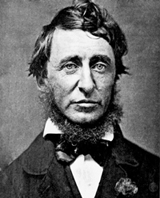
Source: Aldrin Apollo 11, NASA, Wikimedia
“That’s one small step for a man,
one giant leap for mankind.”
Neil Armstrong, American astronaut and the first man to walk on the moon, spoke those momentous words on July 20, 1969. What many great quotations have in common is parallel structure. You’re enough of an expert on parallel structure by now that you probably recognized Armstrong’s use of parallel phrases (one small step for man and one giant leap for mankind) to emphasize the historic significance of the Apollo 11 spaceflight.
Identify the parallel structures in each of the following quotations.

Source: Henry David Thoreau, villy, Wikimedia
I love to weigh, to settle, to gravitate toward that which most strongly and rightfully attracts me.
The infinitive phrases to weigh, to settle, and to gravitate
are parallel in this first quotation. Remember that an infinitive is the base form of a verb, usually preceded by “to.” This quotation stresses the value Thoreau, a nineteenth-century American author and philosopher, placed on following his own interests.

Source: Nelson Mandela, Festival Karsh Ottawa, Flickr
A good head and a good heart are always a formidable combination.
This second quotation is parallel. Again, nouns (head and heart) are paired to convey Mandela’s belief that it is difficult (formidable) to overcome intelligence and passion when they work together. Mandela served as South Africa’s first black president.
Now, let’s move to an exercise called “Recognizing Parallel Structure.” The exercise will ask you to determine if sentences demonstrate parallel structure. After you click the link below, just scroll down and click on “start here.” You will select “Yes! This sentence has an error!” or “No! This sentence is error free!” Click on the “Get an explanation” link under the image on the feedback page to learn more about parallel structure for each sentence. Answer the twenty questions in the exercise and return to the lesson when you are finished. You’ll be directed to print the accompanying handout, but doing so is not necessary. (Note: Barking and applause accompany this exercise. Lower your speaker volume if you are in a library or other quiet space.) Now complete the exercise “Recognizing Parallel Structure.”
Next, you’ll practice completing sentences in a parallel manner. Can you select the best way to complete each of these examples from the Brainy Quote website?

In the following exercise, you will choose the option that maintains parallel structure in the sentences. Don’t forget to take advantage of the explanations. Now complete the exercise “Maintaining Parallel Structure.”
Before each exercise in this section of the lesson, you saw examples of parallel structure from Brainy Quote penned by professional writers such as Henry David Thoreau, Nelson Mandela, Confucius, and Moliere. In the next section, you will look at more professional writing.